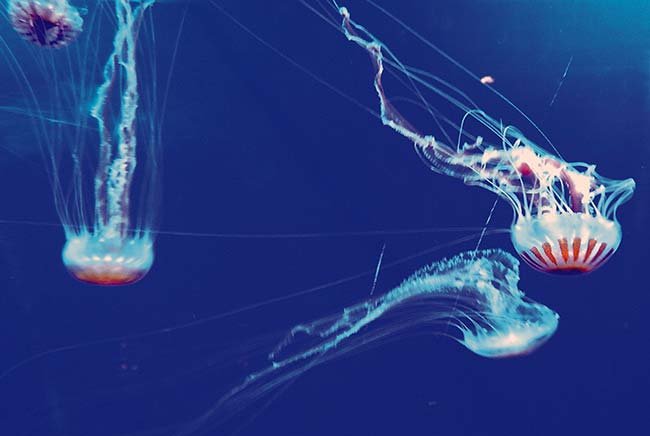
Most everything you've learned about treating jellyfish stings is probably wrong.
BASED ON AN ARTICLE BY By Helen Aitken
At any time during the year, and in every ocean, a dive into the blue could lead to an encounter with jellyfish. The soft-bodied aquatic animals have a distinctive gelatinous umbrella-shaped bell and trailing tentacles, and some can deliver a painful, possibly fatal venomous injection.
Jellyfish are not fish at all, but in fact primitive marine animals that have lived in our oceans for more than 500 million years. They come in a variety of shapes, sizes, and colors, from translucent to vibrant and even luminescent. They range in size from penny-sized freshwater ones to giant pillow-top floating Portuguese man-of-war in saltwater across the world.
Jellyfish float using the currents or swim by moving under water, pulsating up and down by sucking in water and forcing it out. Although encounters may be singular, jellyfish swarms or "blooms" can be exceptionally hazardous and increase the chances of being stung and badly hurt.
Almost all jellyfish have tentacles of various lengths that hang from a flexible gelatinous head. The ends of the tentacles contain specialized stinging cells, called nematocysts, which look like tight springs. When the tentacles touch something, they spring open, firing paralyzing venom into the victim. The prey is then brought underneath the head where the mouth devours it. Even in dead jellyfish, nematocysts fire if touched. Different jellyfish venoms produce distinct pain levels in humans; each requires immediate attention. The stings pose a worldwide health problem, and stings from a few species, like Portuguese man-of-war and the Australian box jellyfish, are life threatening and require treatment with antivenin.
Old wives' tales, information on the internet, and even some first-aid books contain misinformation on how to treat jellyfish stings. In the past, wet tobacco, meat tenderizer, ammonia, ice, and even urine were recommended; these methods have since been proven useless. Topical medications, like calamine and lidocaine, used to treat skin irritations, are also ineffective for neutralizing the venom.
Some of the most comprehensive research on jellyfish stings comes from assistant research professor Angel Yanagihara at the Pacific Biosciences Research Center and John A. Burns School of Medicine in Hawaii. She says the best way to neutralize the venom from jellyfish stings is heat — hot-water immersion for 20 minutes at 108 F to 113 F or applying a medium-temperature (113 F to 130 F) heat pack.
Yanagihara recommends first cleaning the stung area with vinegar, or seawater if vinegar is not available. Vinegar cleans the area, and the acid stops the nondischarged stinging cells from discharging and causing further pain. She advises against using tweezers or scraping with a credit card to remove embedded tentacle parts. They may be virtually undetectable under the skin and could discharge. Taking an antihistamine (such as Benedryl) or applying a topical steroid cream will help reduce inflammation, and taking acetaminophen (Tylenol) or ibuprofen (Advil) can help reduce pain. Of course, it's prudent to see a physician for further treatment, especially for possible embedded cnidae (nematocysts) or multiple stings from dangerous jellyfish.
When stung, victims should try to identify the type of jellyfish or at least describe the shape, size, color, or iridescence. If a box jellyfish or Portuguese man-of-war is suspected, possible side effects of extreme burning pain, difficulty breathing, dry mouth, and extreme anxiety will require a call to 911.
Jellyfish Sting Treatment
- Clean the area with vinegar or seawater — never freshwater.
- Cover the site with a hydrocortisone cream and bandage.
- Use a hot pack, water immersion, or hot-water bottle filled with the hottest tap water (about 120 F) inside a thick towel, and cover the affected area for about 20 minutes.
- Check the area often for blisters or tissue changes, and the patient for increased heart rate.
- Give acetaminophen or ibuprofen for pain (never aspirin to children), unless the victim has been stung near the mouth or is having breathing problems. In this case, go to the hospital.
- Continue using heat therapy as necessary. Seek medical attention if needed.